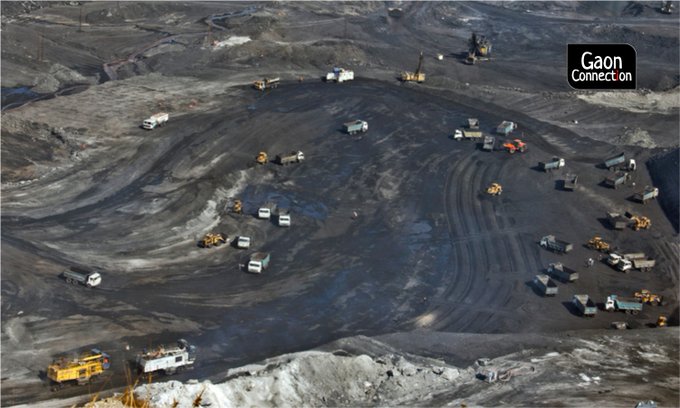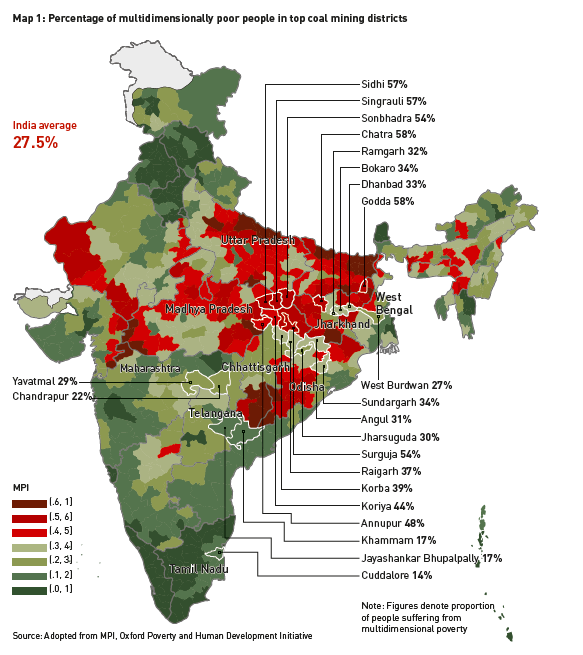Half of Jharkand’s coal mines shut, several others unprofitable; transition away from coal must benefit local communities: iFOREST report
India has only 20-30 years to phase-out coal-based power to avoid catastrophic impacts of climate change. There is an urgent need to plan for a post-coal future, else coal-dependent regions will face major economic and social disruptions in the coming years.


Jharkhand, the third largest coal producing state in India, is facing a decline in coal mining activities as half its coal mines are shut, either permanently or temporarily, and a large chunk of the operational mines are unprofitable. As of June 2020, there were 95 working and 108 temporarily discontinued/non-working coal mines in the state. Most mines have been closed without proper mine closure with no plan for ‘just transition’, which can lead to major economic and social disruptions in the coming years in the mining areas of the state and the country.
These are some of the crucial findings of one-of-its-kind study on ‘just transition’ in coal-rich regions in Jharkhand titled ‘Just Transition in India: An inquiry into the challenges and opportunities for a post-coal future’ released today by iFOREST (International Forum for Environment, Sustainability and Technology), a New Delhi-based non-profit.
“We are mindful that coal will reduce over time, and therefore we have to plan for a post-coal future. As Jharkhand is rich in other natural resources, we are diversifying our economy and promoting tourism, forestry, agro-based industries, and the service sectors,” said Hemant Soren, chief minister of Jharkhand. “Just Transition is a good planning framework for the state government to consider,” he added.

Simply put, ‘just transition’ ensures that the workers and the local communities dependent on fossil fuels like coal do not suffer due to the phase-out of coal to meet the climate change goals listed under the Paris Climate Agreement. It ensures decent work opportunities and social support systems for the people whose livelihood is likely to be affected by the energy transition.
But so far, India has not engaged nationally or internationally on coal phase-out and ‘just transition’ because of the country’s high dependence on coal for energy security and industrial growth. But coal is rapidly losing its cost advantage to renewables, and the supply of affordable 24×7 electricity from solar and wind with battery storage is becoming a reality. In such a situation, coal consumption in the country is projected to peak by 2030 and then start reducing. This will have a significant bearing on coal mining areas, such as in Jharkhand, as coal mines will shut down, reducing jobs and income.
Take the case of Ramgarh district in Jharkhand, which is among the top five coal-producing districts of the state, but its mining activities are shrinking. The iFOREST report, released today, focuses on this district to drive the point about ‘just transition’.
The Ramgarh case study is based on an extensive primary survey of 406 households (selected through stratified random sampling) to ascertain the coal dependency and vulnerability of local communities and capture their perception of coal mine closure and aspirations of alternative livelihoods.
About 50 per cent of mines in Ramgarh district have closed down or have been temporarily discontinued because of various factors, including unprofitability. The rest of the mines (many of them are also unprofitable) have remaining life of about 10-25 years, and there are very few new ones in the pipeline. Therefore, coal mining activities in the district will largely phase out in the next decade or two, making it a perfect case for a prospective ‘just transition’.
The iFOREST report found that one in four households in Ramgarh derived some sort of earning directly from mining and related activities. But this dependence was largely informal and did not provide a decent income. Two-thirds of households reported an income between Rs 6,000-10,000 per month (US$ 85-140/month). This group largely included the ‘non inventoried’ people of the coal-economy, such as coal gatherers and sellers, casual labourers, and daily wagers. Only seven per cent of the households had a member with a formal job in coal mining or related industry.

The district is also marred with poor social and health indicators showing how coal mining had not benefited the region in terms of social and physical infrastructure. For instance, the district has extremely poor primary healthcare infrastructure, with a nearly 50 per cent deficit in the required number of primary healthcare centres. In rural areas, only about 17 per cent of households have access to the piped water supply. Also, a focus on coal mining and related industry over the decades has stymied the development of other sectors and the diversification of the economy.
“Coal mining and coal-dependent industries contribute about 40 per cent of the district’s GDP. Moreover, one-fourth of the households depend directly on the coal industry for income, most of them being informal workers. Without planning for a just transition, the district is already suffering and will suffer immensely in the coming years,” said Shruti Agarwal, Programme Associate, iFOREST.
The transition away from coal is expected to negatively affect the livelihoods and meagre earnings of the local communities on coal mining.
“People in the coal mining areas have been burdened by poverty and under-development for decades. Just transition is an opportunity to reverse this. These districts suffered due to coal mining and are now suffering because of its unplanned closure,” said Srestha Banerjee, Programme Lead, iFOREST. “However, experiences from around the world show that just transition can be a win-win for the environment and the economy if it is planned and managed well,” she added.
And the issue of coal mine closure and just transition isn’t limited to Ramgarh district or Jharkhand alone. It is a national issue.
India is the second largest producer and consumer of coal in the world. With an estimated resource of 326.5 billion tonnes, it themost abundant fossil fuel in the country. Nearly 15 to 20 million people are dependent on coal directly and indirectly for employment and income. Overall, coal mining is a profitable industry. But almost 70 per cent of mines of Coal India Limited, India’s largest coal producer, are running into losses, raising questions about the future of the coal industry.

“Just transition is imperative for India as we have only 20-30 years to phase-out coal-based power to avoid catastrophic impacts of climate change. This is a very short time to transform coal mining areas and coal-dependent industries,” Chandra Bhushan, President & CEO of iFOREST, said during the book release function. “If we do not start planning for a post-coal future now, our coal-dependent regions will face major economic and social disruptions in the coming years,” he warned.
Arjun Munda, Union minister of tribal affairs, who was the chief guest at the concluding session of the book release event, said: “Coal mining areas have a huge potential for redevelopment and become a major source of livelihood for the local communities. For this, the state government and the coal companies should work together to ensure socially-beneficial coal mine closure.”
The iFOREST book, ‘Just Transition in India: An inquiry into the challenges and opportunities for a post-coal future’, highlights the need for the Centre and the state governments to work together to develop just transition policies and plans and mobilise financial resources. It also recommends that India take a leadership role in building an international coalition to support just transition in developing countries.
“By putting just transition at the center of its climate mitigation plan, India can send a strong signal to the world that it is willing to play a leadership role in climate change. Just transition will not only help India push for global collective action, but it will also help build a sustainable and resilient economy in the coal-dependent regions”, said Bhushan. “Coal mines should be closed in a planned fashion so that India’s energy security is not affected, climate goals are met, and the local communities benefit from a just transition,” he added.
As per the ‘just transition’ roadmap offered in the iFOREST report, the central government will have the most crucial role in developing supportive policies and mechanisms. This
will include formulating a just transition policy, supporting and building on existing laws and schemes to enable locally deliverable actions, providing a financial package, and pushing for an international framework to support just transition in developing countries.
The state government, on the other hand, will be at the front line for dealing with just transition by building a broad-based consensus and action plan to phase-out coal mining and strategising the socio-economic transformation using national policy and financial package. Simultaneously, the state should also develop its own economic and industrial strategy to steer away from coal dependence in terms of revenue, employment, and industries.

